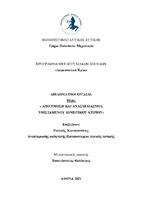| dc.contributor.advisor | Repapis, Constantinos | |
| dc.contributor.author | Βασιλόπουλος, Θεόδωρος | |
| dc.date.accessioned | 2021-11-24T10:07:30Z | |
| dc.date.available | 2021-11-24T10:07:30Z | |
| dc.date.issued | 2021-11-02 | |
| dc.identifier.uri | https://polynoe.lib.uniwa.gr/xmlui/handle/11400/1577 | |
| dc.identifier.uri | http://dx.doi.org/10.26265/polynoe-1428 | |
| dc.description.abstract | Το μεγαλύτερο ποσοστό των δομημάτων (45% του συνόλου) στον Ελλαδικό χώρο έχει μελετηθεί και κατασκευασθεί μεταξύ των δεκαετιών 1960-1980. Οι κανονισμοί που ίσχυαν τότε (φορτίσεως, σκυροδέματος και αντισεισμικός) δεν λάμβαναν υπόψη τους σημαντικούς ελέγχους και αυστηρότερες παραδοχές τα οποία θεσπίσθηκαν αργότερα, συνήθως με αφορμή δυστυχώς κάποιους μεγάλους σεισμούς. Οι σημαντικότερες αλλαγές στους κανονισμούς μπορεί να θεωρηθούν ότι είναι η θέσπιση υψηλότερου σεισμικού συντελεστή σχεδιασμού, ο ικανοτικός έλεγχος, ο έλεγχος κοντού υποστυλώματος, η χρήση καλύτερης ποιότητας υλικών, η δυνατότητα επίλυσης και διαστασιολόγησης πολυπλοκότερων χωρικών προσομοιωμάτων με τη βοήθεια της χρήσης ηλεκτρονικού υπολογιστή, η απαίτηση εφαρμογής αυστηρότερων κατασκευαστικών διατάξεων, η έννοια της πλαστιμότητας και η μετελαστική συμπεριφορά ενός δομήματος. Για τους παραπάνω λόγους και επιπροσθέτως για το γεγονός ότι βλάβες σε παλαιά κτίρια, έπειτα από πρόσφατους σεισμούς, επέφεραν σημαντικό οικονομικό κόστος λόγω αποκατάστασης των ζημιών ή από την παρατεταμένη διάρκεια διακοπής δραστηριοτήτων εντός των κτιρίων λόγω εκτέλεσης των επισκευών, παρόλο που δεν υπήρχε σημαντικό κόστος από απώλειες ζωής, καθιστά πλέον θεμελιώδη τη διαδικασία αποτίμησης της φέρουσας ικανότητας και της τρωτότητας σε ένα πολύ μεγάλο αριθμό δομημάτων στη χώρα και δη δημόσιων κτιρίων που στεγάζουν επιτελικές ή κοινωφελείς υπηρεσίες. | el |
| dc.format.extent | 92 | el |
| dc.language.iso | el | el |
| dc.publisher | Πανεπιστήμιο Δυτικής Αττικής | el |
| dc.rights | Αναφορά Δημιουργού - Μη Εμπορική Χρήση - Παρόμοια Διανομή 4.0 Διεθνές | * |
| dc.rights.uri | https://creativecommons.org/licenses/by-nc-sa/4.0/deed.el | * |
| dc.subject | Αποτίμηση κτιρίων | el |
| dc.subject | Ανασχεδιασμός κτιρίων | el |
| dc.subject | Ενισχύσεις κτιρίων | el |
| dc.subject | Μέθοδος Pushover | el |
| dc.subject | Ανελαστική στατική ανάλυση | el |
| dc.subject | Ελαστική ανάλυση χρονοϊστορίας | el |
| dc.subject | Πλαστιμότητα | el |
| dc.subject | Αποτίμηση φέρουσας ικανότητας | el |
| dc.subject | Τρωτότητα κατασκευών | el |
| dc.subject | ΚΑΝΕΠΕ | el |
| dc.title | Αποτίμηση και ανασχεδιασμός υφιστάμενου δημοτικού κτιρίου | el |
| dc.title.alternative | Evaluation and redesign of an existing municipal building | el |
| dc.type | Μεταπτυχιακή διπλωματική εργασία | el |
| dc.contributor.committee | Δημάκος, Κωνσταντίνος | |
| dc.contributor.committee | Pnevmatikos, Nikos | |
| dc.contributor.faculty | Σχολή Μηχανικών | el |
| dc.contributor.department | Τμήμα Πολιτικών Μηχανικών | el |
| dc.contributor.master | Δομοστατικά Έργα | el |
| dc.description.abstracttranslated | The majority of buildings in Greece (45% of total) have been planned and built between the 1960s and 1980s. The building regulations in place at that time (loading, reinforced concrete and seismic codes), did not take into account the essential controls and the stricter projections that were adopted later, usually and unfortunately in connection with some larger earthquakes. One might regard that the most significant changes in the regulations are the adoption of a higher seismic design coefficient, the capacity design check, the short column check, the use of higher quality materials, the capacity to calculate and size more complex spatial simulations with the use of a computer, the concept of ductility, the post-elastic behavior of a building and the demand for the use of stricter building provisions. For the reasons described above and in addition because of the fact that damages in old buildings caused by recent earthquakes resulted in significant financial costs for damage repairs, or costs due to the prolonged period of seizure of activities that take place in these buildings until the completion of required repairs, despite the fact that there was no significant cost in terms of loss of life, makes it imperative that a large number of buildings and in particular public buildings housing executive or civil services be evaluated for their load bearing capacity. | el |


